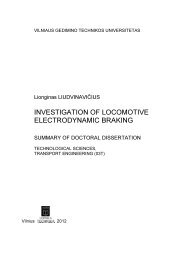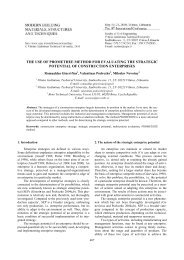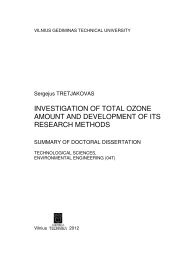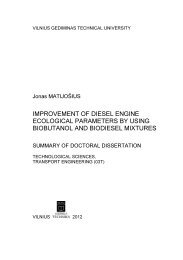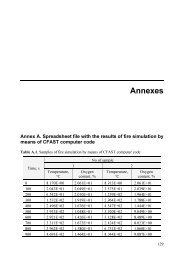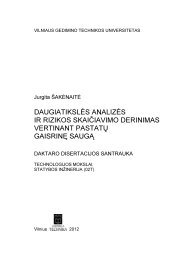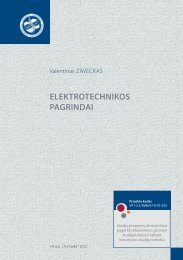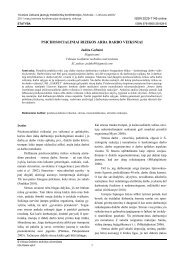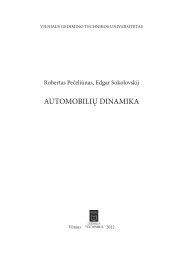tribological properties of biodiesel fuel and its mixtures with diesel fuel
tribological properties of biodiesel fuel and its mixtures with diesel fuel
tribological properties of biodiesel fuel and its mixtures with diesel fuel
You also want an ePaper? Increase the reach of your titles
YUMPU automatically turns print PDFs into web optimized ePapers that Google loves.
Proceedings <strong>of</strong> the 6 th International Scientific Conference TRANSBALTICA 2009Vilnius Gediminas Technical UniversityTransport Engineering FacultyJ. Basanavičiaus g. 28LT-03224, Vilnius, Lithuaniahttp://www.vgtu.lt/english/editionsTRIBOLOGICAL PROPERTIES OF BIODIESEL FUEL AND ITS MIXTURESWITH DIESEL FUELVytautas Bučinskas 1 , Rimantas Subačius 21 Department <strong>of</strong> Machine Engineering, Vilnius Gediminas Technical University; J. Basanavičiaus str 28,LT-03224 Vilnius, Lithuania, E-mail: vytautas.bucinskas@fm.vgtu.lt2 Department <strong>of</strong> Railway Transport, Vilnius Gediminas Technical University, J. Basanavičiaus str 28, LT-03224Vilnius, Lithuania. E-mail: rimant@ti.vgtu.ltAbstract. Implementation <strong>of</strong> <strong>bio<strong>diesel</strong></strong> <strong>fuel</strong> in bus fleet or other responsible transport requires research <strong>of</strong> <strong>bio<strong>diesel</strong></strong><strong>properties</strong>, influencing lifetime <strong>of</strong> machines <strong>and</strong> performance quality. One <strong>of</strong> important side <strong>of</strong> <strong>fuel</strong> <strong>properties</strong> is<strong>tribological</strong> <strong>properties</strong> <strong>of</strong> <strong>fuel</strong>s <strong>and</strong> <strong>mixtures</strong> <strong>of</strong> them <strong>with</strong> <strong>diesel</strong> <strong>fuel</strong>. Due to different origin <strong>and</strong> chemical structure, real<strong>fuel</strong> can contain non-stable states <strong>of</strong> liquid <strong>with</strong> undesired behavior in real <strong>fuel</strong> system. Such situation can causeundesired wearing <strong>of</strong> sliding surfaces in case <strong>of</strong> low lubricating film, seizing <strong>of</strong> jets in case <strong>of</strong> undesired sticking to metal<strong>and</strong> create big general resistance <strong>of</strong> <strong>fuel</strong> system.Aim <strong>of</strong> the paper is to reveal results <strong>and</strong> noticed <strong>properties</strong> <strong>of</strong> such <strong>mixtures</strong> using HVAC test <strong>and</strong> create some points instable mixture behavior.Paper includes description <strong>of</strong> experiment, experiment equipment, methodology <strong>of</strong> experiment. Further results <strong>and</strong> graphs<strong>of</strong> most remarkable tests are presented <strong>and</strong> conclusions are made.Keywords: <strong>bio<strong>diesel</strong></strong>, <strong>tribological</strong> <strong>properties</strong>, coeficient <strong>of</strong> friction, lubricant film propery.1. IntroductionNew politics <strong>of</strong> EU for renewable <strong>fuel</strong> <strong>and</strong>requirements to increase use <strong>of</strong> it naturally raisesimportance <strong>of</strong> bio <strong>fuel</strong> quality. Newest direction inrenewable energy implementation is bio-<strong>diesel</strong> <strong>and</strong> <strong>its</strong>derivatives. Biological <strong>and</strong> low performed <strong>fuel</strong>s areknown [1–14], but actuality <strong>of</strong> nowadays pushestechnology to intensify use <strong>of</strong> bio-<strong>diesel</strong> <strong>fuel</strong>s in<strong>mixtures</strong> <strong>with</strong> common <strong>diesel</strong> <strong>fuel</strong>. Use <strong>of</strong> <strong>bio<strong>diesel</strong></strong>sin modern <strong>diesel</strong> engines requires new geometry <strong>of</strong> jetsystems <strong>and</strong> friction surfaces [8].Different way <strong>of</strong> producing – distillation <strong>and</strong>cold extracting for petro- <strong>and</strong> biological <strong>diesel</strong> <strong>fuel</strong>smakes mixture <strong>of</strong> them possibly non-uniformconsistent <strong>and</strong> can raise problems on <strong>fuel</strong> injectionsystem.Bio<strong>diesel</strong> is defined as mono-alkyl esters <strong>of</strong> longchain fatty acids derived from vegetable oils oranimal fats which conform to ASTM D6751specifications for use in <strong>diesel</strong> engines. Bio<strong>diesel</strong>refers to the pure <strong>fuel</strong> before blending <strong>with</strong> <strong>diesel</strong><strong>fuel</strong>. Bio<strong>diesel</strong> blends are denoted as, “BXX” <strong>with</strong>“XX” representing the percentage <strong>of</strong> <strong>bio<strong>diesel</strong></strong>contained in the blend (ie: B20 is 20 % <strong>bio<strong>diesel</strong></strong>,80 % petroleum <strong>diesel</strong>).Problematic can be lubricating <strong>properties</strong> <strong>of</strong> themixture, which can cause seizing <strong>of</strong> contacting detailsin <strong>fuel</strong> jet system. This characteristic is sufficientlyrepresented by coefficient <strong>of</strong> friction <strong>of</strong> <strong>fuel</strong> <strong>and</strong> <strong>fuel</strong>film <strong>properties</strong>. Research <strong>of</strong> <strong>tribological</strong> <strong>properties</strong> <strong>of</strong>composed <strong>bio<strong>diesel</strong></strong> <strong>and</strong> <strong>diesel</strong> <strong>fuel</strong> <strong>mixtures</strong> isimportant to ensure long lifetime <strong>and</strong> high quality <strong>of</strong>engine systems [9].2. Formulation <strong>of</strong> investigationMain aim <strong>of</strong> experimental research is to detectmain dependencies <strong>of</strong> <strong>tribological</strong> <strong>properties</strong> for purepetro <strong>diesel</strong>, pure bio <strong>diesel</strong> <strong>and</strong> <strong>mixtures</strong>.Experimental research <strong>of</strong> <strong>tribological</strong> <strong>diesel</strong> <strong>fuel</strong><strong>and</strong> <strong>its</strong> <strong>mixtures</strong> is performed using wear <strong>and</strong> frictiontest machine, according st<strong>and</strong>ard procedure [11].During testing procedure test samples, consisting <strong>of</strong>selected by specific <strong>properties</strong> petro <strong>diesel</strong> <strong>and</strong> <strong>its</strong><strong>mixtures</strong> was tested for coefficient <strong>of</strong> friction <strong>and</strong>physic wearing values.Values <strong>of</strong> coefficient <strong>of</strong> friction in time makes agraph <strong>and</strong> these values are used to calculate meanvalue <strong>of</strong> it. This method allows minimize influence <strong>of</strong>temperature <strong>and</strong> layers <strong>of</strong> non mixed test specimen.Additionally lubricant film property existence isevaluated during the same test. Value <strong>of</strong> lubricatingfilm is measure in per cents for very time moment <strong>and</strong>also create graph, samples <strong>of</strong> which are represented inresult section (fig. 3–4).So, finally, task <strong>of</strong> experimental research retrievementioned above quality parameters for a different24
V. Bučinskas, R. Subačius / TRANSBALTICA 2009types <strong>of</strong> <strong>bio<strong>diesel</strong></strong> <strong>and</strong> <strong>mixtures</strong> <strong>with</strong> oil <strong>diesel</strong>.Fuel film <strong>properties</strong> are important not only in<strong>tribological</strong> point <strong>of</strong> view, but also in the case <strong>of</strong>atomization <strong>of</strong> <strong>fuel</strong> into droplets during jettingprocess. Fundamental <strong>and</strong> experimental research [10],[11] in this field shows dependency <strong>of</strong> droplet size<strong>and</strong> <strong>fuel</strong> film property.General task <strong>of</strong> all research can be expressed asfinding optimal ratio range <strong>of</strong> <strong>bio<strong>diesel</strong></strong> <strong>and</strong> <strong>diesel</strong> <strong>fuel</strong>mixture from <strong>tribological</strong> point <strong>of</strong> view <strong>and</strong> thisresearch is starting point in it.nent humidity <strong>and</strong> permanent temperature 60° C.3. Experimental techniqueAs equipment for a experimental research wasused HFFR [9] test machine (fig. 1) <strong>with</strong> 4 rollingballs on control plane. Methodology <strong>of</strong> procedure isdescribed in ASTM D6079-99 St<strong>and</strong>ard Test Methodfor Evaluating Lubricity <strong>of</strong> Diesel Fuels by the High-Frequency Reciprocating Rig (HFRR) <strong>and</strong> in analogISO st<strong>and</strong>art.Fig. 2. Universal machine for HFFR testAs output <strong>of</strong> experimental research are theseparameters – instant coefficient <strong>of</strong> friction, instantlubricating <strong>fuel</strong> film quality (in percents), longitudinal<strong>and</strong> transverse wear <strong>of</strong> specimen ball, overall wear(both in micrometers), stability <strong>of</strong> lubricating filmover the cycle <strong>of</strong> testing. All output characteristics areprescribed by HFFR st<strong>and</strong>ard [11]. In this case wear<strong>of</strong> surfaces in tested <strong>fuel</strong> represent integral output <strong>of</strong>efficient <strong>tribological</strong> <strong>properties</strong>.4. EquipmentFig. 1. HFFR test friction pair:1 – ball; 2 – plane; 3 – direction <strong>of</strong> movementSpecimens for the test were selected fromavailable source <strong>of</strong> Polish <strong>and</strong> Lithuanian origins.There were used two samples from differentproducers in Lithuania <strong>and</strong> some producers in Pol<strong>and</strong>.In the testing research program was included two pureLithuanian <strong>bio<strong>diesel</strong></strong> samples, Lithuanian petroleum<strong>diesel</strong> <strong>with</strong> <strong>bio<strong>diesel</strong></strong>, the same <strong>with</strong> Polish madespecimens.According description test was continued permanently75 minutes <strong>of</strong> pure testing time. Used type <strong>of</strong>specimen was used ball <strong>and</strong> plate, load to specimenpair – 0,2 kg. Amplitude <strong>of</strong> recoprocating was takenas 1 mm. Test was performed in conditions <strong>of</strong> perma-Testing machine performs st<strong>and</strong>ard testprocedure on <strong>diesel</strong> <strong>fuel</strong>, which is st<strong>and</strong>ard fordefining lubricating <strong>properties</strong> <strong>of</strong> sample <strong>fuel</strong>. Duringtest lubricity characteristics are taken as indicativeparameters, described above, <strong>and</strong> as real wear sizes,measured after test procedure.5. ResultsGiven results represent tendencies in existing<strong>bio<strong>diesel</strong></strong> products <strong>and</strong> grades them <strong>tribological</strong><strong>properties</strong>. Of course, <strong>tribological</strong> <strong>properties</strong> notrepresent overall quality, but lack <strong>of</strong> lubricatingfacilities prevents use <strong>of</strong> such <strong>fuel</strong>.Results <strong>of</strong> lubricating film value distribution <strong>of</strong>tested samples are presented in fig. 3.1 2 3 4 5Fig. 3. Distribution <strong>of</strong> lubrication film values in most characteristic samples:1 – <strong>diesel</strong> <strong>fuel</strong> basis (no additives, pol.); 2 – <strong>diesel</strong> <strong>fuel</strong> (lit.); 3 – agricultural <strong>diesel</strong> <strong>fuel</strong> (lit.); 4 – 100 % <strong>bio<strong>diesel</strong></strong> (pol.);5 – 100 % <strong>bio<strong>diesel</strong></strong> old (lit.)100%80%60%40%20%0%25
V. Bučinskas, R. Subačius / TRANSBALTICA 20090,450,40,350,30,250,20,150,10,0500,4480,1620,160,141 0,141 2 3 4 5Fig. 4. Distribution <strong>of</strong> coefficient <strong>of</strong> friction values in most characteristic samples:1 – <strong>diesel</strong> <strong>fuel</strong> basis (no additives, pol.); 2 – <strong>diesel</strong> <strong>fuel</strong> (lit.); 3 – agricultural <strong>diesel</strong> <strong>fuel</strong> (lit.); 4 – 100 % <strong>bio<strong>diesel</strong></strong> (pol.);5 – 100 % <strong>bio<strong>diesel</strong></strong> old (lit.)Distribution <strong>of</strong> coefficient <strong>of</strong> friction in testsamples is presented below <strong>and</strong> shows wide range <strong>of</strong>it. This experimental research evidently requiresincrease numbers <strong>of</strong> test samples, because values aremuch dispersed.During experimental research not samples <strong>with</strong>certain <strong>properties</strong> can be selected as good (fig. 5) orpoor (fig. 6). Good results <strong>of</strong> regular <strong>diesel</strong> can beused as st<strong>and</strong>ard <strong>of</strong> <strong>tribological</strong> quality <strong>of</strong> <strong>diesel</strong> <strong>fuel</strong>.Graph in fig.6 contains results <strong>of</strong> test <strong>of</strong> puredistillate <strong>of</strong> <strong>diesel</strong> <strong>fuel</strong>, which evidently shows thatpure lubricating <strong>properties</strong> <strong>of</strong> such sample <strong>and</strong>definitely not applicable. High coefficient <strong>of</strong> friction<strong>and</strong> bad lubricant film quality point this test sample asunacceptable quality.Fig. 5. Perfect <strong>tribological</strong> characteristics (Polish origin regular <strong>diesel</strong> <strong>fuel</strong>)Fig. 6. Bad sample <strong>of</strong> <strong>diesel</strong> distillate basis (Polish origin, <strong>with</strong>out additives)26
V. Bučinskas, R. Subačius / TRANSBALTICA 20096. ConclusionsTribological <strong>properties</strong> <strong>of</strong> <strong>bio<strong>diesel</strong></strong> <strong>and</strong> <strong>diesel</strong>mix can be very different <strong>and</strong> increase <strong>of</strong> bio <strong>fuel</strong>origins requires wider research. Initial researchrevealed some interesting dependencies <strong>and</strong> furtheranalysis <strong>and</strong> research required. To get more detailedresults, it is necessary perform more experimentaltests <strong>with</strong> bigger variety <strong>of</strong> materials. Also percentage<strong>of</strong> bio <strong>diesel</strong> in mixture is not clear yet; nevertheless ast<strong>and</strong>ard for this is presented.Research, presented in paper letting us to makethese conclusions:1. Tribological <strong>properties</strong> <strong>of</strong> pure <strong>bio<strong>diesel</strong></strong>samples from different origin have better values, thanpure oil distillates.2. Pure <strong>bio<strong>diesel</strong></strong> testing specimen shows lower<strong>tribological</strong> <strong>properties</strong> then the <strong>mixtures</strong> <strong>with</strong> <strong>diesel</strong><strong>fuel</strong>.3. Regular <strong>diesel</strong> <strong>fuel</strong>s have more stable<strong>properties</strong>, than pure <strong>bio<strong>diesel</strong></strong>s, which is caused bydifference in production process – <strong>bio<strong>diesel</strong></strong>s are notdistilled, their raw material also differs.References1. Chavanne, G. 1937 08 31. Procédé de transformation d’huiles végétales en vue de leur utilisation comme carburants(Procedure for the transformation <strong>of</strong> vegetable oils for their uses as <strong>fuel</strong>s). Belgian Patent 422,877. Chem Abstr. 32:4313.Cited in Knothe (2005b).2. Török Á. 2009. Theoretical estimation <strong>of</strong> the environmental impact <strong>of</strong> bi<strong>of</strong>uel <strong>mixtures</strong>, Transport 24(1): 26–29.3. Raslavičius, L.; Markšaitis, D. 2007. Research into three-component <strong>bio<strong>diesel</strong></strong> <strong>fuel</strong>s combustion process using a singledroplet technique, Transport 22(4): 312–315.4. Lebedevas, S.; Vaicekauskas, A.; Suškov, P. 2007. Presumptions <strong>of</strong> effective operation <strong>of</strong> <strong>diesel</strong> engines running on rme<strong>bio<strong>diesel</strong></strong>. Research on kinetics <strong>of</strong> combustion <strong>of</strong> RME <strong>bio<strong>diesel</strong></strong>, Transport 22(2): 126–133.5. Boychenko S., Shkilnuk I., Turchak V. 2008. The problems <strong>of</strong> biopollution <strong>with</strong> jet <strong>fuel</strong>s <strong>and</strong> the way <strong>of</strong> achievingsolution, Transport 23(3): 253–257.6. Lingaitis, L. P.; Pukalskas, S. 2008. Ecological aspects <strong>of</strong> using biological <strong>diesel</strong> oil in railway transport, Transport23(2): 138–143.7. Lingaitis, L. P.; Pukalskas, S. 2008. The economic effect <strong>of</strong> using biological <strong>diesel</strong> oil on railway transport, Transport23(4): 287–290.8. Pianthong, K.; Matthujak, A.; Takayama, K.; Milton, B. E. <strong>and</strong> Behnia, M. 2008. Dynamic characteristics <strong>of</strong> pulsedsupersonic <strong>fuel</strong> sprays. Shock Waves 18(1), SA.9. Bučinskas, V.; Subačius, R.; Mokšin, V. <strong>and</strong> Vekteris, V. 2006. Investigation <strong>of</strong> Quality Change in LocomotiveLubricant. Solid State Phenomena 113: 420–424.10. Analyzing <strong>bio<strong>diesel</strong></strong>: st<strong>and</strong>ards <strong>and</strong> other methods Gerhard Knothe. Journal <strong>of</strong> the American Oil Chemists’ Society, 2006,83(10).11. ASTM D6079-99 St<strong>and</strong>ard Test Method for Evaluating Lubricity <strong>of</strong> Diesel Fuels by the High-Frequency ReciprocatingRig (HFRR). ASTM International/10-Nov-1999/4 pages. REPLACED by ASTM D6079-02.12. Drown, D. C.; Harper, K. <strong>and</strong> Frame E. 2001. Screening vegetable oil alcohol esters as <strong>fuel</strong> lubricity enhancers. Journal<strong>of</strong> the American Oil Chemists’ Society 78(6).13. Shi1, H.-H.; Takayama, K. 1999. Generation <strong>of</strong> hypersonic liquid <strong>fuel</strong> jets accompanying self-combustion. Shock Waves9(5): 327–332.14. Yuan, W.; Hansen, A. C.; Zhang, Q.; Tan, Z. 2005. Temperature-dependent kinematic viscosity <strong>of</strong> selected <strong>bio<strong>diesel</strong></strong><strong>fuel</strong>s <strong>and</strong> blends <strong>with</strong> <strong>diesel</strong> <strong>fuel</strong>. Journal <strong>of</strong> the American Oil Chemists’ Society 82(3): 195–199.27



